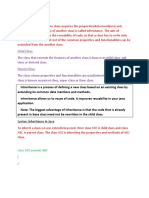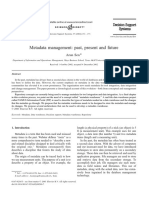Inheritance in Object OOP JavaScript
Uploaded by
COD PIRATESInheritance in Object OOP JavaScript
Uploaded by
COD PIRATESInheritance: Building on Existing Classes in JavaScript (Simplified)
Imagine your school system. You want to represent both Professors and Students in your
program. While they have different roles and responsibilities, they share some common
traits: they both have names and can introduce themselves.
Instead of creating separate classes for each, you can leverage inheritance. This allows
you to reuse code and build on existing classes. Let's see how:
Step 1: Define the "Person" base class:
Think of it as the common ground for both professors and students.
class Person {
constructor(name) {
this.name = name;
}
introduceSelf() {
console.log(`My name is ${this.name}.`);
}
}
Step 2: Derive "Professor" and "Student" from "Person":
Use the extends keyword to tell them they inherit from Person.
class Professor extends Person {
constructor(name, teaches) {
super(name); // Call parent constructor
this.teaches = teaches;
}
gradePaper(paper) {
console.log(`Grading ${paper}...`);
}
// Override introduceSelf to add professor details
introduceSelf() {
super.introduceSelf(); // Call parent introduceSelf
console.log(`...and I teach ${this.teaches}.`);
}
}
class Student extends Person {
constructor(name, year) {
super(name);
this.year = year;
}
introduceSelf() {
super.introduceSelf();
console.log(`...and I'm in year ${this.year}.`);
}
}
Benefits of Inheritance:
● Code reuse: Share common features like name and introduceSelf instead of
duplicating code.
● Reduced complexity: Organize your classes logically and avoid repeating yourself.
● Polymorphism: Different classes can implement the same method (e.g.,
introduceSelf) in their own unique way.
Key points to remember:
● Superclass: The "parent" class (e.g., Person) providing the base functionality.
● Subclass: The "child" class (e.g., Professor, Student) inheriting from the superclass
and adding specific details.
● extends: Keyword used to define a subclass based on a superclass.
● super(): Used in the subclass constructor to call the parent constructor and initialize
inherited properties.
● Override: When a subclass redefines a method already present in the superclass.
Example usage:
const walsh = new Professor("Walsh", "Psychology");
walsh.introduceSelf(); // "My name is Walsh. ...and I teach
Psychology."
const summers = new Student("Summers", 1);
summers.introduceSelf(); // "My name is Summers. ...and I'm in year
1."
const pratt = new Person("Pratt");
pratt.introduceSelf(); // "My name is Pratt."
With inheritance, your code becomes cleaner, more organized, and easier to maintain, just
like a well-structured school system!
You might also like
- Object Oriented Programming With The TypescriptNo ratings yetObject Oriented Programming With The Typescript33 pages
- DynamicsAX 2009 Development Best Practices White PaperNo ratings yetDynamicsAX 2009 Development Best Practices White Paper158 pages
- JavaScript Classes - Inheritance-For LoopNo ratings yetJavaScript Classes - Inheritance-For Loop25 pages
- 10 React Class Based Components and PropsNo ratings yet10 React Class Based Components and Props43 pages
- Child Class:: The Class That Extends The Features of Another Class Is Known As Child Class, Sub Class or Derived ClassNo ratings yetChild Class:: The Class That Extends The Features of Another Class Is Known As Child Class, Sub Class or Derived Class4 pages
- Ch2-Inheritance Polymorphism InterfacesNo ratings yetCh2-Inheritance Polymorphism Interfaces51 pages
- Core Java OOPS Concept Notes With ExampleNo ratings yetCore Java OOPS Concept Notes With Example20 pages
- CS 1101-03 Programming and Problem Solving: Fall 2016No ratings yetCS 1101-03 Programming and Problem Solving: Fall 201621 pages
- Inheritance Ensures Reusability Example of Inheritance What Is Actually Inherited? Overloading vs. OverridingNo ratings yetInheritance Ensures Reusability Example of Inheritance What Is Actually Inherited? Overloading vs. Overriding10 pages
- CSC584 Enterprise Programming: Chapter 1 - Review of Object-Oriented ProgrammingNo ratings yetCSC584 Enterprise Programming: Chapter 1 - Review of Object-Oriented Programming54 pages
- CS102 Chapter4 INHERITANCE POLYMORPHISMNo ratings yetCS102 Chapter4 INHERITANCE POLYMORPHISM32 pages
- I Nheritance: Classes and Subclasses or Extending A ClassNo ratings yetI Nheritance: Classes and Subclasses or Extending A Class26 pages
- 60a17aae57a0d41ba0b52c54 - AP CS A Study Guide Unit 9No ratings yet60a17aae57a0d41ba0b52c54 - AP CS A Study Guide Unit 97 pages
- Inheritance: CS F213: Object Oriented ProgrammingNo ratings yetInheritance: CS F213: Object Oriented Programming16 pages
- Object Oriented Programming Inheritance: Fundamentals and ApplicationsFrom EverandObject Oriented Programming Inheritance: Fundamentals and ApplicationsNo ratings yet
- IGNOU PGDCA MCS 206 Object Oriented Programming using Java Previous Years solved PapersFrom EverandIGNOU PGDCA MCS 206 Object Oriented Programming using Java Previous Years solved PapersNo ratings yet
- TCS Most Frequently Asked Technical Interview QuestionsNo ratings yetTCS Most Frequently Asked Technical Interview Questions8 pages
- II-CIA - Java Programming - MCQs - 03.03.2023No ratings yetII-CIA - Java Programming - MCQs - 03.03.202317 pages
- Comparison Index C++ Java: Platform-Independent C++ Is Platform-Dependent. Mainly Used ForNo ratings yetComparison Index C++ Java: Platform-Independent C++ Is Platform-Dependent. Mainly Used For11 pages
- Updating IBM Cognos 8 Models Using Code and XMLNo ratings yetUpdating IBM Cognos 8 Models Using Code and XML24 pages
- 115 Java Interview Questions and Answers - The ULTIMATE List PDFNo ratings yet115 Java Interview Questions and Answers - The ULTIMATE List PDF28 pages
- Class Notes For CSCI 104: Data Structures and Object-Oriented DesignNo ratings yetClass Notes For CSCI 104: Data Structures and Object-Oriented Design206 pages
- Pyparsing Docs Readthedocs Io en LatestNo ratings yetPyparsing Docs Readthedocs Io en Latest92 pages
- Metadata Management - Past, Present and Future PDFNo ratings yetMetadata Management - Past, Present and Future PDF23 pages
- Interview Question For Python Interview - Mid RoleNo ratings yetInterview Question For Python Interview - Mid Role10 pages
- Complete PHP Secrets & Tips For ProfessionalsNo ratings yetComplete PHP Secrets & Tips For Professionals404 pages

























































































